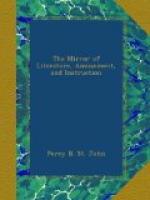And then concludes with some excellent sentiments:—
“Though ev’ry man’s
a nat’ral right
To shew a moderate nose,
Yet surely ’tis a piece of spite
To spoil the world’s
repose.
‘Tis wrong t’ exhibit such
a show,
Though you may think it fun
Yet still, good Sir, you little know
What evil it has done.
What quarrels have from hence begun!
What anger and what strife!
What blows have pass’d ’tween
man and man!
What kicks ’tween man
and wife!
No longer, then, thyself disgrace,
In quest of beauty’s
fame;
No longer, then, expose thy face,
To get thy nose a name.
Take it away, if thou art wise,
And keep it safe at home,
Amongst thy curiosities
Of ancient Greece and Rome.”
Shakspeare would have thought it high treason, for he says,—
“Down with the nose, take the bridge
quite away
Of him, that his particular to forefend
Smells from the general weal.”
There may have been many other such noses that have escaped observation,—“born to blush unseen:” enough, however, I have here stated of those my recollection furnishes me with at the moment, to establish the fact of variety, and to lead curious physiologists to a scientific classification of this prominent and well-deserving feature of the human face. I would recommend a proper distinction being observed between functional varieties, and those which arise from size, shape, or colour, of which, in a cursory way, may be enumerated first,—
Shape.[9]
Roman. Snub. Flat. Bottle nose, Grecian. Pug. Sharp. Parrotical nose.
Colour.
Red. Malmsey. Purple. Ruby. Claret. Copper.
[9] Lavater considers the nose
as the fulcrum of the brain; and
describes it as a piece of Gothic architecture.
“It is in the
nose that the arch of the forehead properly
rests, the weight of
which, but for this, would mercilessly crush
the cheeks and the
mouth.” He enters into the philosophy
of noses with diverting
enthusiasm, and finally concludes, “Non
cuique datum est habere
nasum:”—it is not every one’s
good fortune to have a nose! A
sharp nose has been considered the visible
mark of a shrew.
Now, what does all this come to? Cui bono? A great deal for surgery; let us examine what may be done;—we know that noses may be supplied,—may not, therefore, a small one be enlarged, and a large one made small? We have seen a person with a bunch of noses, but can only, on the authority of Shakspeare, quote one “who had a thousand.”
For a great length of time nothing was admired in the world but Roman noses,—and then not a word was heard about them, till William III. brought them again into fashion.




